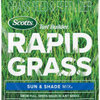Renovating Lawn - Tamping Soil?
16 years ago
Related Stories

GARDENING GUIDESHow to Prep Your Ground for a Healthy New Lawn
Seed or sod that falls on weedy, lumpy soil is a wasted effort. Follow these steps to ensure that your new lawn will thrive
Full Story
LANDSCAPE DESIGNCalifornia Says Goodbye to the Sprawling Ornamental Lawn
New state rules will effectively limit turfgrass to 25 percent of the landscape in most new and renovated yards
Full Story
FRONT YARD IDEASBefore and After: Front Lawn to Prairie Garden
How they did it: Homeowners create a plan, stick to it and keep the neighbors (and wildlife) in mind
Full Story
LANDSCAPE DESIGNGet Along With Less Lawn — Ideas to Save Water and Effort
Ditch the mower and lower your water bill while creating a feast for the eyes with diverse plantings and gathering places
Full Story
LAWN ALTERNATIVESStop Fighting the Patchy Lawn!
Here are 3 situations where a garden may be a better idea than more turfgrass
Full Story
GREAT HOME PROJECTSHow to Replace Your Lawn With a Garden
New project for a new year: Lose the turfgrass for energy savings, wildlife friendliness and lower maintenance
Full Story
GARDENING GUIDESSmall Gem Lawns: More Impact From Less Grass
Instead of letting the lawn sprawl, make it a shapely design element in your yard. You’ll reap benefits both practical and aesthetic
Full Story
SAVING WATERHouzz Call: Are You Letting Go of Your Lawn?
Many facing a drought are swapping turf for less thirsty plantings. If you’re one of them, we’d like to hear about it
Full Story
REMODELING GUIDES10 Things to Do Before the Renovation Begins
Prep and plan with this insight in hand to make your home remodeling project run more smoothly
Full Story
SAVING WATERXeriscape Gardens: How to Get a Beautiful Landscape With Less Water
Conserve water and make gardening much easier with the xeriscape approach’s 7 principles
Full Story






decklap
arjo_reichOriginal Author
Related Professionals
Milwaukee Landscape Architects & Landscape Designers · Owings Mills Landscape Architects & Landscape Designers · River Forest Landscape Architects & Landscape Designers · Salisbury Landscape Architects & Landscape Designers · Manchester Landscape Contractors · Woburn Landscape Contractors · Barrington Landscape Contractors · Bridgeport Landscape Contractors · Euclid Landscape Contractors · Fairfield Landscape Contractors · Palatine Landscape Contractors · Round Lake Landscape Contractors · West Orange Landscape Contractors · Four Corners Landscape Contractors · Lauderdale Lakes Landscape Contractorsjeannie7
arjo_reichOriginal Author
User
decklap
bpgreen
dchall_san_antonio
arjo_reichOriginal Author
decklap
arjo_reichOriginal Author
dchall_san_antonio
decklap
dchall_san_antonio